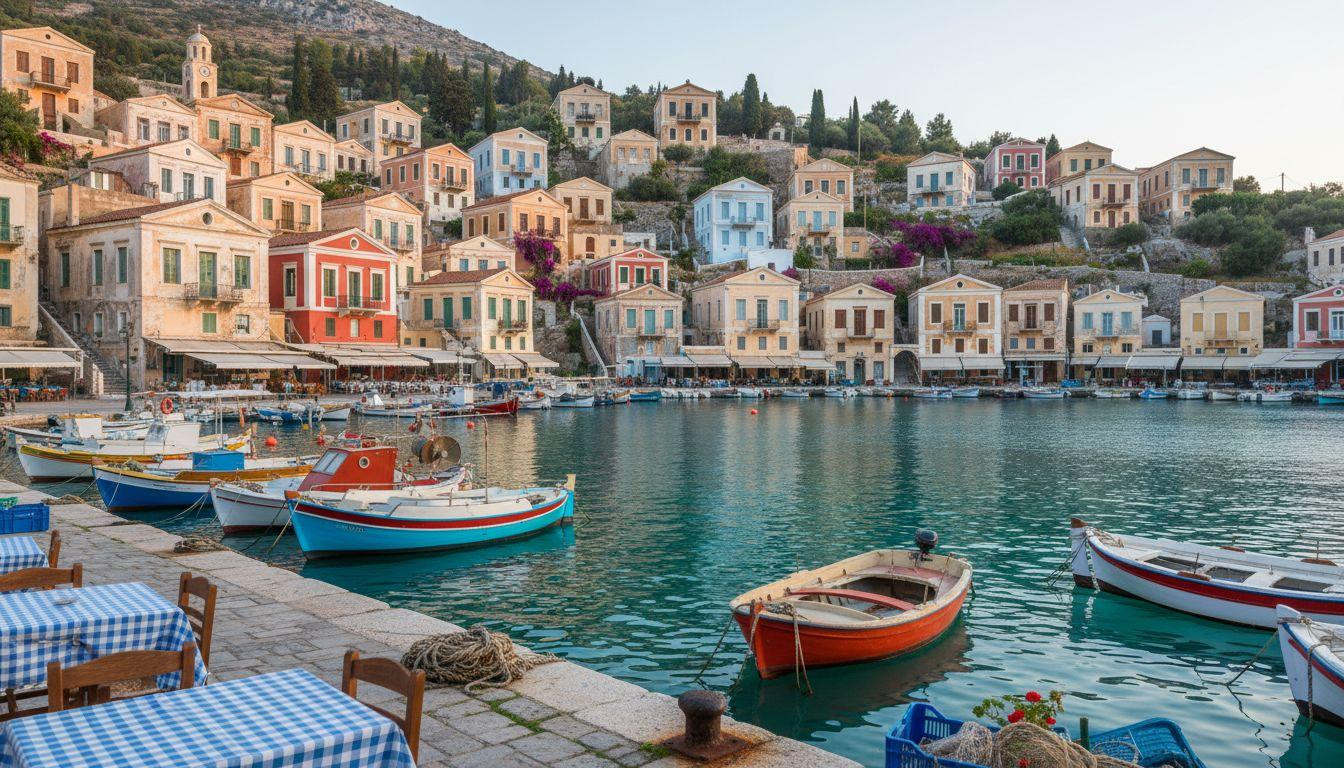Pastel houses glow pink at 6:42 AM when Symi’s harbor wakes to the gentle sound of fishing boats. The neoclassical townhouses cascade in perfect tiers around Gialos harbor like an amphitheater painted in soft yellows, blues, and terracotta. Steam rises from waterfront cafes as the Aegean reflects this 19th-century masterpiece. Only 2,600 residents call this Dodecanese island home, creating an intimacy that larger Greek destinations have lost forever.
The harbor that Instagram can’t quite capture
Symi’s neoclassical architecture emerged between 1860-1910 from sponge diving wealth. Italian craftsmen sourced wood and Marseilles roof tiles created this unique palette. The amphitheater layout means every building catches morning light differently. Photos flatten what is actually three-dimensional magic unfolding across steep hillsides.
Golden hour transforms the harbor into liquid amber. Shadows climb pastel walls as the sun sets behind Chorio’s upper town. The clock tower stands sentinel over 350 neoclassical structures that survived because locals fought development. This isn’t tourist theater but living heritage where Rhodes beaches and ancient ruins feel crowded by comparison.
Where sponge diving built a color palette
The maritime heritage that still lives
Three sponge shops operate from the same families since 1890. Symi Sponges, Nireus Store, and Poseidon Workshop sell natural sponges harvested locally. The Nautical Museum displays ship models and diving equipment in a preserved neoclassical building. Entry costs $5 but tells the story of when 22,500 people lived here during the 19th-century boom.
One traditional boatyard remains active. An 82-year-old craftsman builds wooden caiques using unchanged methods. His workshop smells of pine tar and varnish. Visitors watch him shape hulls that will fish these waters for decades.
The architecture that wealthy captains left behind
Sponge diving profits funded these elegant townhouses. Symmetrical facades feature wooden shutters and pediments mimicking ancient temples. Ocher dominates today’s palette at 45%, terracotta at 25%, azure at 20%, white at 10%. Originally, buildings displayed more vibrant colors before preservation efforts standardized the scheme.
Heritage site designation since 1975 protects Gialos, Chorio, Pedi, and Nimborio. Building regulations require traditional materials and prohibit facade alterations. Maximum height stays at three stories. These restrictions preserve the intimate scale that makes Symi extraordinary.
Living at the pace of ferry schedules
The 90-minute journey from Rhodes
High-speed catamarans carry 150-200 passengers while regular ferries hold 80-120. Peak season brings 6-8 daily departures, November reduces this to 2-3. Day-trippers arrive 9:30-11:00 AM and leave 3:30-5:30 PM. A new $3 fee for day visitors started July 2025 to manage overtourism.
Ferry tickets cost $25-35 depending on boat type. Organized day tours from Rhodes run $55-75 including transport. Dodecanese island hopping guides recommend staying overnight to experience Symi after crowds depart. Only 22% of visitors sleep here.
Where 2,600 residents share six beaches
St. George Bay offers pristine water accessed by $5 water taxi rides. Nos Beach provides pebbled shores and cliff backdrops. Swimming directly from Gialos harbor is possible in calm conditions. Water temperature reaches 64°F in November, 75°F in summer.
Beach access remains unhurried even during peak season. Small scale means encountering maybe 200 overnight tourists versus thousands on larger islands. The 15-20 minute walk from harbor to upper Chorio climbs exactly 500 stone steps worn smooth by centuries of use.
The sunset ritual nobody talks about
Crowds chase Santorini’s caldera drama while Symi offers something quieter. Chorio hilltop provides harbor views as shadows climb pastel walls. The Kali Strata staircase descent at golden hour reveals how evening light transforms each building. Local families emerge after day-trippers leave.
Harbor tavernas charge $25-35 for fresh fish dinners with waterfront views. Walk 100 meters inland and family spots serve mezze for $12-15. The island specialty, tiny fried Symi shrimps, appears on every menu. Evening brings the sound of backgammon pieces clicking and church bells marking time.
Your questions about Symi answered
How crowded does Symi actually get?
Day boats bring 1,000-5,000 visitors during peak season May-October. Total island population swells to 6,000 on busy summer days. Stay past 5:30 PM when ferries depart and find empty streets. November brings only locals and handful of overnight guests. Similar preserved villages face identical seasonal patterns.
Is the food authentic or tourist-priced?
Harbor restaurants target day-trippers with $30-40 seafood platters. Inland family tavernas serve identical Symi shrimps for $15-20. Local bakeries sell traditional sweets and fresh bread. Grocery stores stock basics but selection remains limited on this small island. Three pharmacies serve residents and visitors year-round.
How does Symi compare to Santorini for couples?
Santorini offers dramatic cliffs and sunset crowds with $200+ hotel rates. Symi provides neoclassical beauty at $90-165 nightly with quiet mornings you’ll remember. Both islands feature Instagram-worthy architecture but Symi delivers intimacy impossible in Santorini’s tourist machine. Remote islands worldwide increasingly attract travelers seeking authentic experiences.
November light softens the harbor’s pastels into watercolor perfection. Fishing boats prepare for dawn departures as steam rises from morning coffee. The amphitheater of neoclassical houses glows quietly in the Aegean sun, waiting for the day’s first ferry to arrive.
